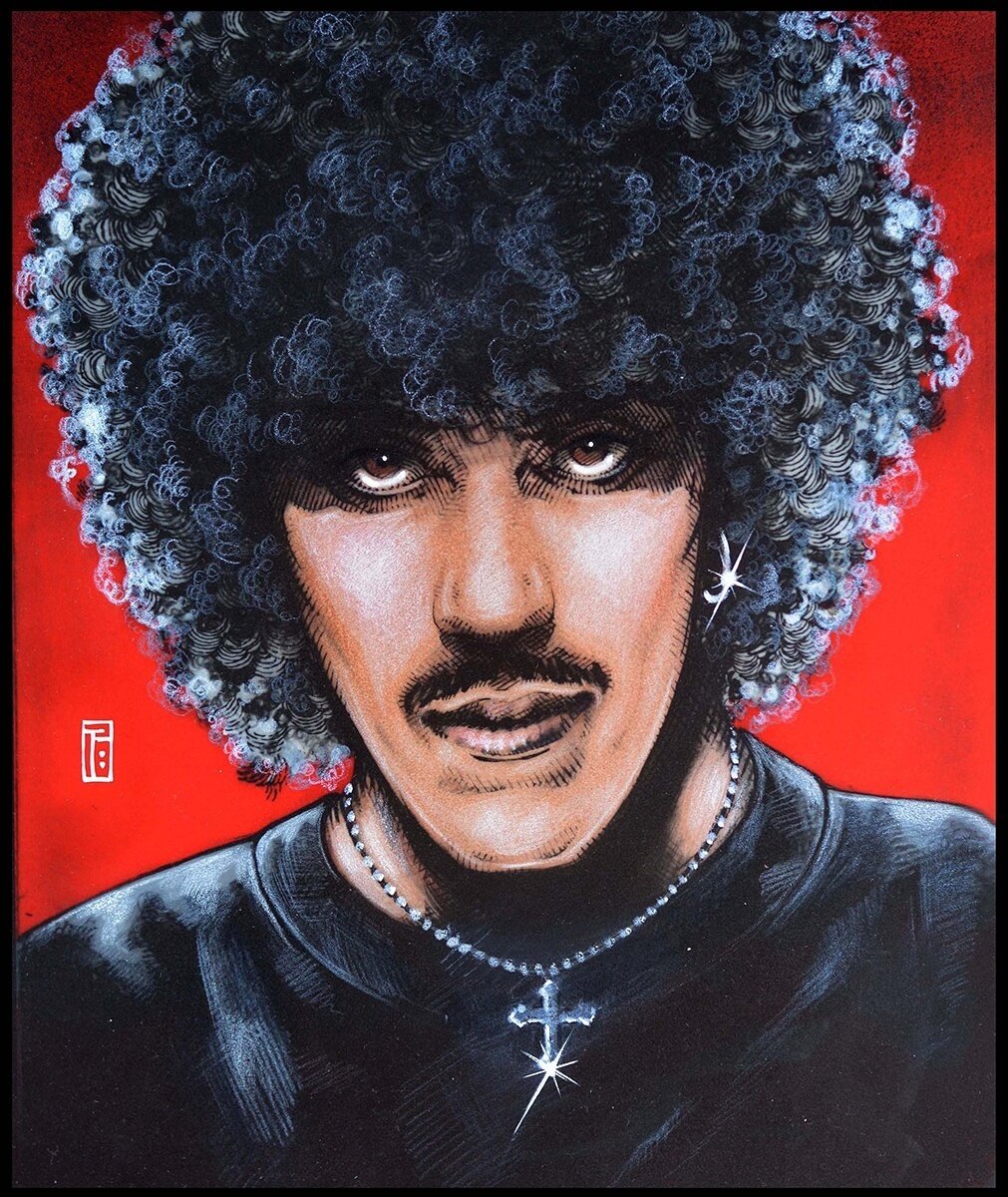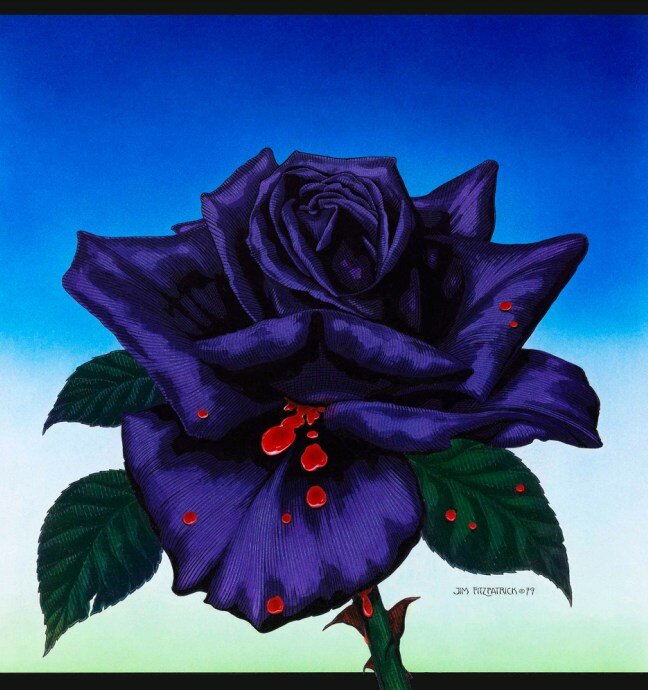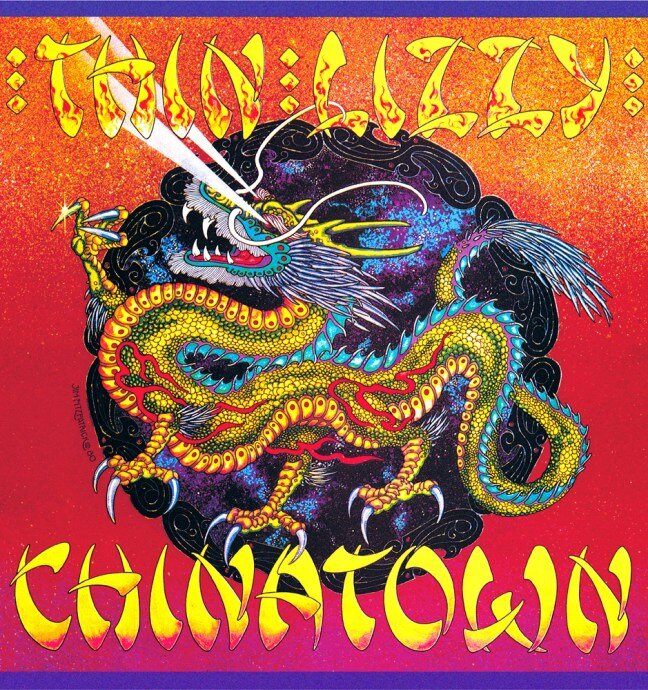The Epic Legacy of Phil Lynott
Jim Fitzpatrick’s portrait of Lynott.
When Jimmy Page, Ritchie Blackmore, Lemmy Kilmister, Gene Simmons, Brian May--and most of the guys in Iron Maiden--consider you one of the greats in the history of rock…maybe you are.
Phil Lynott would've turned seventy-two today. He shares his birthdate with H.P. Lovecraft, Robert Plant and Dimebag Darrell. 2021 also marks the thirty-fifth anniversary of Phil's untimely death on January 4th, 1986. I intended to commemorate that anniversary this last January, but bringing things together for the 2021 DMR Guest Bloggerama tied me up to the point that I didn't think I could do Lynott justice. It is time to make up for that lapse.
Phil--affectionately known as 'Philo', especially in Ireland--was raised in Dublin by his grandparents. In 1969, Lynott put together Thin Lizzy. An excellent account of Lynott and the early days of Thin Lizzy can be found here.
It was during that early stage of the band's career that Phil was approached by none other than Deep Purple's Ritchie Blackmore. Ritchie wanted to form a power trio with Lynott as the singer and bassist. The plan fell through, but the whole affair demonstrates the respect that Phil was already garnering even in the highest echelons of metal/hard rock.
Jim Fitzpatrick’s illo for Thin Lizzy’s single, ‘The Rocker’.
Around the same time, Lynott met a popular Dublin artist named Jim Fitzpatrick. Jim painted the cover for Lizzy's 1973 LP, Vagabonds of the Western World. After Fitzpatrick had done a couple of other covers for rock bands that same year, Phil asked Jim to be the 'exclusive artist' for Thin Lizzy. The two became good friends, a relationship that would last until Lynott's death. The most iconic artwork of Thin Lizzy's career would result from that pact. Would either of them be quite as well-known today without the other? Perhaps it’s best not to dwell on that.
Around the same time, due to the departure of original guitarist, Eric Bell, Phil would bring on Gary Moore as Lizzy's guitarist. Gary had this observation:
'[Phil] was always trying to prove himself, He had to be the guy who could outfight anyone, could pull more chicks, drink more.'
As if there was any doubt that Philo was Irish to his core.
Moore would record a few tracks for Nightlife and leave.
By 1974, Lynott was looking to upgrade Lizzy's sound. Wishbone Ash was playing harmony leads in a hard rock context. On top of that, guitarist Gary Moore had abruptly left the band, just as Eric Bell had before him. Philo decided that having two guitarists would be good insurance. He planned to up the ante laid down by Wishbone Ash, hiring newcomers Scott Gorham and Brian Robertson as guitarists. Thin Lizzy would do harmony leads, but do them better and harder. The first glimmerings of the classic Lizzy sound would be heard on 1975's Fighting. Glenn Tipton of Judas Priest was a Thin Lizzy fan at the time and paid close attention to that LP.
Thin Lizzy's biggest album in the States, 1976's Jailbreak, features a triptych of songs which place it within the ranks of proto-Epic Metal. The first is the title track, 'Jailbreak'. The tune concerns a tyrannical, technocratic panopticon in the near future. The entire idea is so far-fetched it almost forces me to place the song in the 'fantasy' category.
Here's a snippet:
Tonight there's gonna be a breakout
Into the city zones
Don't you dare to try and stop us
No one could for long
Anthrax, The Dropkick Murphys and Jerry Cantrell have all covered this Lizzy classic.
Jim Fitzpatrick describes the process wherein he and Lynott hashed out the basic plot:
'Myself and Philip were both very influenced by H.G.Wells' War of the Worlds and American Marvel comics; Philip wanted something that reflected these influences and this artwork [for the Jailbreak LP] was the result. Together we worked on the imaginary story of ‘The Warrior’ that Philip had in his mind and I reworked the roughs to reflect this idea until it all held together.'
The next proto-Epic Metal track would be 'Warriors':
I am the warrior
I serve the death machine
Losers or conquerors
All flash past on my silver screen
However, the piece de resistance is 'Emerald':
Down from the glen came the marching men
With their shields and their swords
To fight the fight they believed to be right
And overthrow the overlords
Without a doubt, 'Emerald' is one of the foundational tracks in the evolution of Epic Metal. The lyrics, the driving rhythm and the harmony lead guitars were a template followed by Iron Maiden and many, many other metal bands in years to come. Ace Frehley and Mastodon have covered 'Emerald', but neither measure up, in my opinion.
Jailbreak was the band's peak in many ways, both artistically and commercially. Various negative factors then came into play, despite the momentum generated by such an instantly-classic album. A good account of that period can be found here. Lynott contracted hepatitis and guitarist Brian Robertson had his hand cut open with a broken bottle during a barroom brawl. The legendary wildness of the band was coming back to haunt them. Thin Lizzy would never really ‘break big’ in the US market.
Fitzpatrick’s original painting for Thin Lizzy’s 1979 LP, Black Rose.
There is a dispute regarding just when heroin entered the equation. Brian Robertson says one thing--i.e., that Phil contracted hepatitis in 1976 because of a dirty needle--and Gorham another; that he and Lynott started using in 1979. Whichever it is, heroin has been shown to be (almost) universally destructive to rock bands throughout the history of the genre.
Thin Lizzy would remain heavy hitters in the UK and Europe for the next half decade, but the decline had set in. Brian Robertson left and Gary Moore came back for Black Rose, an uneven LP which reaches Jailbreak-level heights on some tracks, but is not as good. Reportedly, Moore--never much of a team player--didn't care for the harmony leads that Phil wanted.
One classic song from Black Rose is the title track, which is also borderline Epic Metal:
Tell me the legends of long ago
When the kings and queens
Would dance in the realm of the Black Rose
Play me the melodies I want to know
So I can teach my children, oh
Pray tell me the story of young Cuchulainn
How his eyes were dark his expression sullen
And how he'd fight and always won
And how they cried when he was fallen
Oh, tell me the story of the queen of this land
And how her sons died at her own hand
And how fools obey commands
Oh, tell me the legends of long ago
Where the mountains of Mourne
Come down to the sea
Will she no come back to me?
Will she no come back to me?
The mention of the legendary Irish hero, Cuchulainn, is no accident. Lynott identified heavily with that figure from Erin's past. Here is Jim Fitzpatrick to talk about it:
'Philip loved the works of darker poets from Edgar Allan Poe to Brendan Behan, who both met untimely deaths. Philip’s fascination with Cú Chulainn was centred on how the young hero blazed through life like a comet across the sky and seemed to have a death wish by playing with fire.'
I am personally a fan of the Chinatown album--Phil was probably getting some of his heroin in London's Chinatown at that point--but it simply wasn't as strong as Jailbreak or even Black Rose. The following LP, Renegade, is only worthwhile for the proto-Epic Metal track, 'Angel of Death', which is pretty awesome.
1983's Thunder and Lightning marked a short-lived resurgence for the band. Lynott kicked out the lukewarm Snowy White for the young n' hungry John Sykes. Sykes, from the Elrically-named Tygers of Pan Tang, was one of the better guitarists in the UK metal scene at the time. 'Cold Sweat', one of the stand-out tracks from the album, was cited by Dimebag Darrell of Pantera as being among his top ten favorite songs.
Phil's heroin addiction continued apace. He dissolved the band, at which point Scott Gorham sought treatment at the behest of long-time Thin Lizzy fan and supporter, Jimmy Page.
Lynott spiraled downward from there. He had a hit single with Gary Moore, 'Out in the Fields', but the man was in free fall. A succinct account of Phil's final days can be found here. Such talent and good-heartedness…wasted.
Moral of the story: Do not do heroin.
All of this is a fairly long-winded prologue to the question: What was Phil Lynott's legacy?
As stated earlier, Iron Maiden is the foremost exemplar of the template Thin Lizzy laid down. In the early days of Maiden's existence, more than one perceptive critic called them 'Thin Lizzy on speed'. With the replacement of Paul Di'Anno on vocals by Bruce Dickinson, the connection might be harder for some metal fans to spot. Vocalists carry undue weight when assessing a band's overall sound. With Bruce onboard, Maiden became 'Lizzy with Ronnie James Dio'. The core sound of Maiden was always derived from Lizzy. Steve Harris has admitted his admiration for Lynott, right down to copying Philo's mirrored pickguard. Dave Murray and Adrian Smith are both Thin Lizzy fans. Maiden's 'Different World' from 2006, with uncharacteristic vocals by Bruce, has been stated by the band as being an homage to Lynott.
An instance of Phil's influence upon the metal scene of the 1990s--which decade was my personal 'glory days' period--can be seen in Corrosion of Conformity's hit song, 'Clean My Wounds'. At the time, I told friends that Pepper Keenan was doing an homage to Lynott/Lizzy with that tune. Lo and behold! My Google Fu last night discovered the fact that, yes, Keenan called it the 'Thin Lizzy Song' until he came up with lyrics for it. The patented Lynott staccato rhythm and harmony leads give it away.
Despite the fact that Lynott played bass and not guitar, all accounts are unanimous in stating that Philo guided the sound of Thin Lizzy—in its entirety—every step of the way, from 1971 to 1983. Lynott was an alpha male with a vision. He made that vision happen, however imperfectly.
I visited Phil's statue in Dublin in 2019. A tribute to one of the great Dubliners. I just learned today that another statue to Philo is going to be erected in England. In addition, we have the stamps issued by the Republic of Ireland a few years ago in honor of Phil.
I read about Lynott's death in Rolling Stone the week after it happened. I remember exactly where I was when I read it. The same thing happened to an Irish writer about the same age. Check it out here.
Lynott's constitution was often likened to that of a bull or a horse. He survived his lifestyle far longer than some thought likely. He was the wildest of Irish rovers and blessed with the 'soul of a poet'—as so many have said, then and now. I hope he found some peace. The legacy he bequeathed to his fans can never be erased.
Phil’s long-time girlfriend, Gale Claydon, knew him through the early years of Thin Lizzy. She once said:
‘He was never one of those people who were going to grow old. You just couldn’t see Phil with a bald spot and creaking limbs. He was a rock star. He’d made his mind up about that long before he became one. And he’s still a rock star now.’
Ar dheis de go raibh a anam, Philip.
*All illustrations in this blog entry courtesy of Jim Fitzpatrick.






